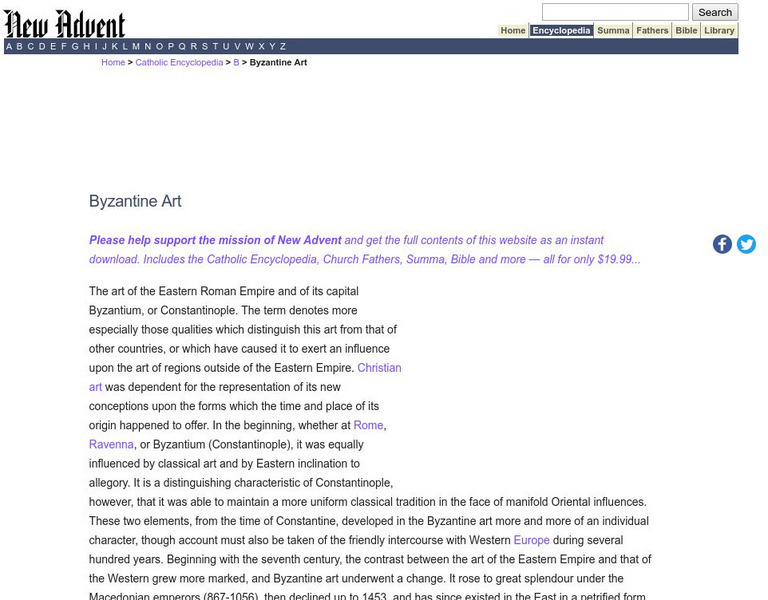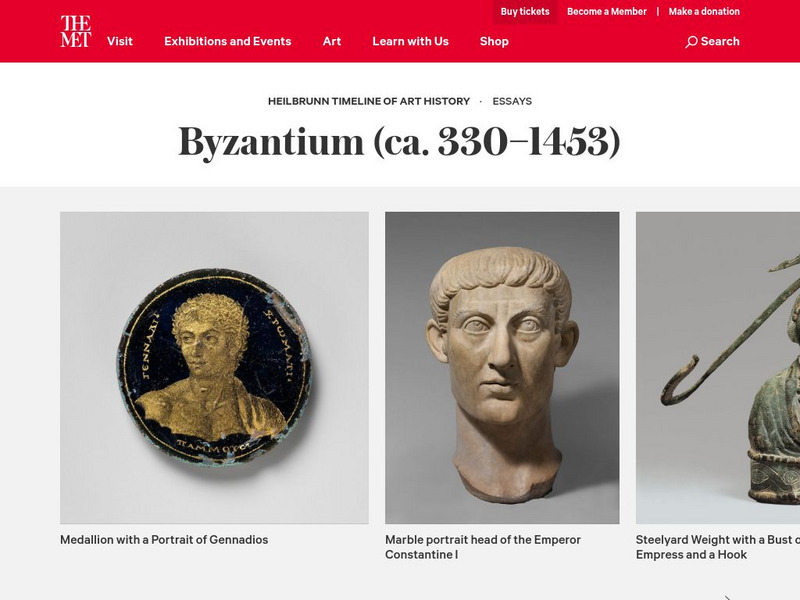Curated OER
The Influence of The Byzantine Empire on Russia and Eastern Europe
Students examine the influence on Russian and Eastern European language, religion, art, and architecture by the Byzantine Empire. They define key vocabulary terms, listen to a lecture and participate in a class discussion, and label a map.
Curated OER
The Art of the Byzantine Empire
Eighth graders describe, analyze, and evaluate the history of the Byzantine Empire and Russia from about 300 to 1000 A.D. They emphasis the preservation of Greek and Roman traditions. Students analyze the Byzantine art and architecture.
Curated OER
Justinian I
Students research emperor Justinian I in this lesson. They identify the contributions of Theodora to Justinian's rule, and the expansion of the Byzantine Empire during this time. They then analyze the contributions of Byzantine on...
Curated OER
D E S I G N A N I C O N
Students examine the meaning, importance and influence of the icon in the lives of Russians, explore the Byzantine influence on Russian culture and the themes represented in icon painting. Students view some of the famous icons that have...
Cave Creek Unified School District
Crusades and Culture in the Middle Ages
The Crusades sounds like a glamorous time period in the Middle Ages full of glory—but was it? Scholars find and review the truth of the Crusades' influence on the world through the resource. The study guides, separated individually by...
Curated OER
Byzantine Civilization: The Missing Link
Students connect their study of the Roman Empire to their study of the Byzantine Civilization. In this ancient history lesson, students study the time period between the fall of the Roman Empire and the rise of the Byzantine.
Curated OER
The Byzantine Empire and the Rise of Russia
Eighth graders examine the Byzantine Empire and the rise of Russia. In this world history lesson, 8th graders complete a webquest that requires them to research the Hagia Sophia, Byzantine art, and Byzantine leadership.
Curated OER
The Byzantine Church and the Schism
Students examine the role of the church in the Byzantine Empire, and the importance that relgion has played in the development of socieites. They research the events that led up to the division of the Byzantine church, and the...
Curated OER
Final Regents Review: Rome
Take a trip to ancient Rome in this presentation, which includes details about Roman life, society, politics, and religion. Viewers will be enthralled with the vivid maps and pictures in these slides, which could lead to a discussion on...
Curated OER
Early Russian History
While not heavy in text, the vivid images, maps, and key information in this slide show, are sure to hold an audience. They'll view images of geography, buildings, and people who are apart of early Russian History. Use the presentation...
Curated OER
Enduring Influence: Rome, Greece, and Byzantium
Pupils explore ancient cultures. In this ancient history lesson, students view programs that depict the ancient Roman, Greek, and Byzantine cultures. Pupils consider how archaeologists, geologists, and scientists have uncovered the...
Curated OER
Islam or Christianity?
Learners design a mosaic depicting the city of Constantinople during determined periods of history. They include historical evidence that shows whether the city was under Muslim or Christian rule.
Curated OER
"What Was Rome"
Eighth graders study the richness, diversity and significance of Roman Civilization. They demonstrate in what ways Rome has influenced subsequent civilizations and what is meant by the "Fall of the Roman Empire". They clarify that...
Miama-Dade County Public Schools
Ancient Rome
This resource outlines several general activities for a study of Ancient Rome, and includes guiding questions, a handout on the story of Romulus and Remus, and ideas for incorporating mapping and timeline activities into your review.
Curated OER
The Fascinating World of Islam
Students participate in viewing the PBS video series Islam: Empire of Faith. They research aspects of the world of Islam by using the internet and other research tools. They create, in groups, an ABC Book of Islam based on their research.
New Advent
Catholic Encyclopedia: Byzantine Art
A nice overview of Byzantine art. The website provides details on the influence of, its characteristics, and some of the more well-known examples. Please note that ?The Catholic Encyclopedia? is a historic reference source and should be...
United Nations
Unesco: Ancient City of Damascus
Damascus in Syria was founded in the third millennium BC. Its long history reveals the influences of many ancient civilizations, most particularly the Hellenistic, Roman, Byzantine and Islamic civilizations. This World Heritage website...
Curated OER
Unesco: Greece: Paleochristian and Byzantine Monuments of Thessalonika
Founded in 315 B.C., the provincial capital and sea port of Thessalonika was one of the first bases for the spread of Christianity. Among its Christian monuments are fine churches, some built on the Greek cross plan and others on the...
Metropolitan Museum of Art
Metropolitan Museum of Art: Byzantium
From the Metropolitan Museum of Art, view an excellent online exhibit of artwork created during the Middle Byzantine period from 843 to 1261. Religious influences during this time were the inspiration for art, and this exhibit provides a...
Metropolitan Museum of Art
Metropolitan Museum of Art: "The Epiphany" by Giotto
An example of the work of Giotto (Giotto di Bondone), "The Epiphany," from about 1320. Showcases Giotto's innovative style and discusses his break with the Bzyantine tradition, which, up until now, had been exerting a strong influence...
Curated OER
Unesco: Italy: Longobards in Italy. Places of the Power (568 774 a.d.)
The Longobards in Italy, Places of Power, 568 - 774 A.D. comprises seven groups of important buildings (including fortresses, churches, and monasteries) throughout the Italian Peninsula. They testify to the high achievement of the...
Curated OER
Unesco: Ukraine: Residence of Bukovinian and Dalmatian Metropolitans
The Residence of Bukovinian and Dalmatian Metropolitans represents a masterful synergy of architectural styles built by Czech architect Josef Hlavka from 1864 to 1882. The property, an outstanding example of 19th-century historicist...



















